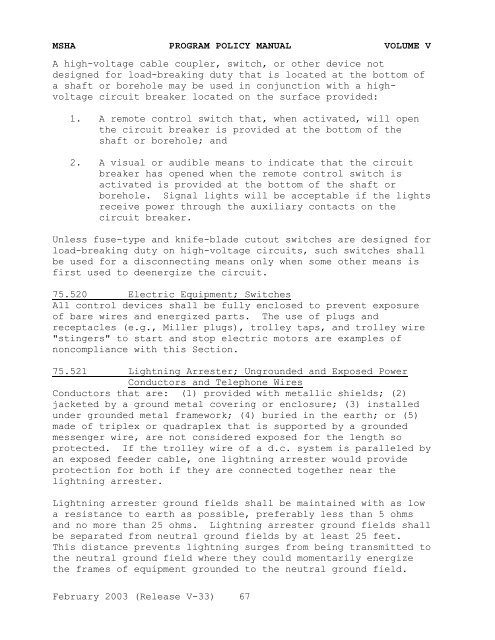Program Policy Manual - VOLUME V - Mine Safety and Health ...
Program Policy Manual - VOLUME V - Mine Safety and Health ...
Program Policy Manual - VOLUME V - Mine Safety and Health ...
You also want an ePaper? Increase the reach of your titles
YUMPU automatically turns print PDFs into web optimized ePapers that Google loves.
MSHA PROGRAM POLICY MANUAL <strong>VOLUME</strong> V<br />
A high-voltage cable coupler, switch, or other device not<br />
designed for load-breaking duty that is located at the bottom of<br />
a shaft or borehole may be used in conjunction with a highvoltage<br />
circuit breaker located on the surface provided:<br />
1. A remote control switch that, when activated, will open<br />
the circuit breaker is provided at the bottom of the<br />
shaft or borehole; <strong>and</strong><br />
2. A visual or audible means to indicate that the circuit<br />
breaker has opened when the remote control switch is<br />
activated is provided at the bottom of the shaft or<br />
borehole. Signal lights will be acceptable if the lights<br />
receive power through the auxiliary contacts on the<br />
circuit breaker.<br />
Unless fuse-type <strong>and</strong> knife-blade cutout switches are designed for<br />
load-breaking duty on high-voltage circuits, such switches shall<br />
be used for a disconnecting means only when some other means is<br />
first used to deenergize the circuit.<br />
75.520 Electric Equipment; Switches<br />
All control devices shall be fully enclosed to prevent exposure<br />
of bare wires <strong>and</strong> energized parts. The use of plugs <strong>and</strong><br />
receptacles (e.g., Miller plugs), trolley taps, <strong>and</strong> trolley wire<br />
"stingers" to start <strong>and</strong> stop electric motors are examples of<br />
noncompliance with this Section.<br />
75.521 Lightning Arrester; Ungrounded <strong>and</strong> Exposed Power<br />
Conductors <strong>and</strong> Telephone Wires<br />
Conductors that are: (1) provided with metallic shields; (2)<br />
jacketed by a ground metal covering or enclosure; (3) installed<br />
under grounded metal framework; (4) buried in the earth; or (5)<br />
made of triplex or quadraplex that is supported by a grounded<br />
messenger wire, are not considered exposed for the length so<br />
protected. If the trolley wire of a d.c. system is paralleled by<br />
an exposed feeder cable, one lightning arrester would provide<br />
protection for both if they are connected together near the<br />
lightning arrester.<br />
Lightning arrester ground fields shall be maintained with as low<br />
a resistance to earth as possible, preferably less than 5 ohms<br />
<strong>and</strong> no more than 25 ohms. Lightning arrester ground fields shall<br />
be separated from neutral ground fields by at least 25 feet.<br />
This distance prevents lightning surges from being transmitted to<br />
the neutral ground field where they could momentarily energize<br />
the frames of equipment grounded to the neutral ground field.<br />
February 2003 (Release V-33) 67
















